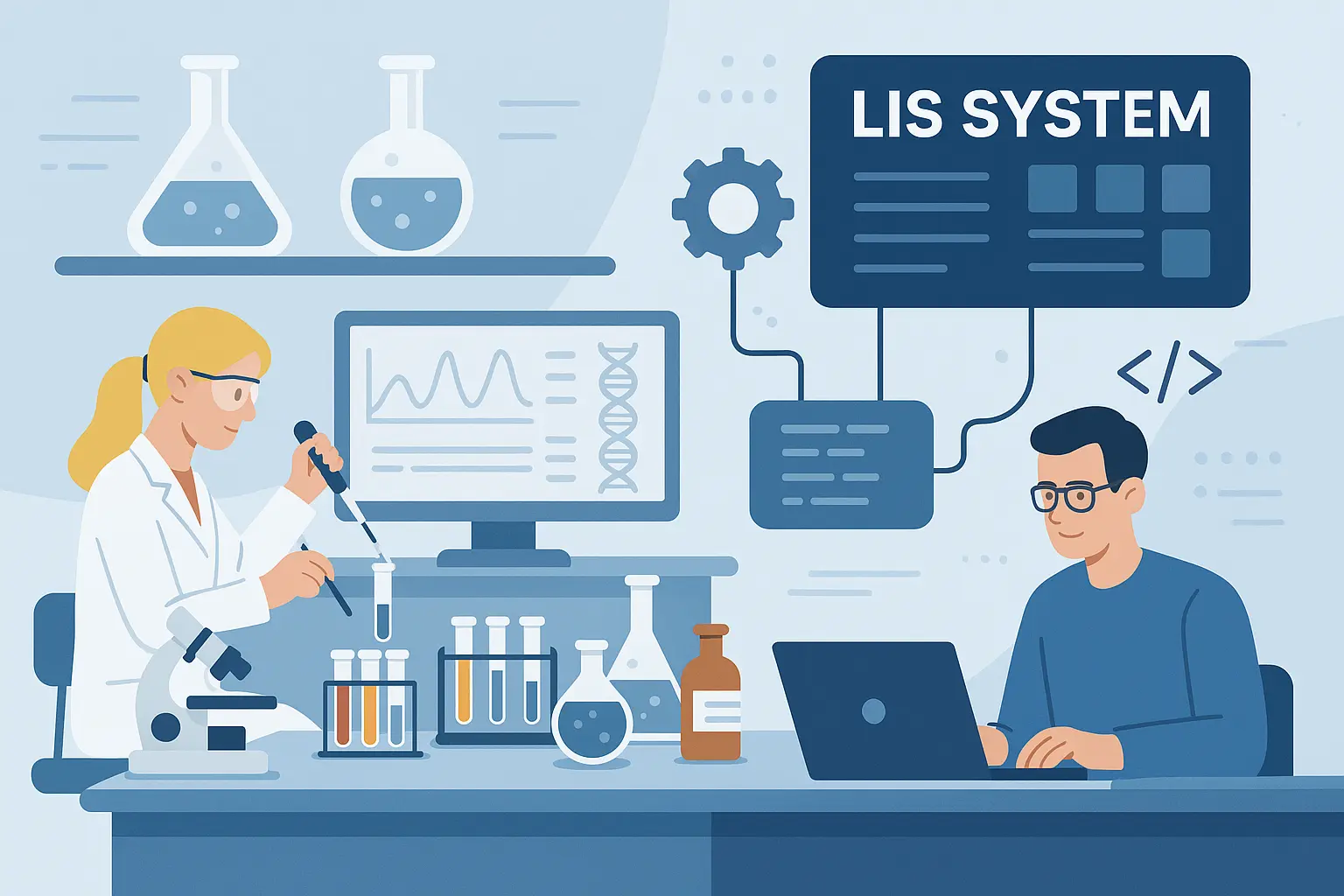Blog
How to Set Up a Committee to Select a Laboratory Information System
September 16, 2024
Selecting a new laboratory information system (LIS system, also known as pathology lab software) is a pivotal decision for any laboratory, affecting its operational efficiency, addressing staffing challenges, and maximizing overall laboratory workflow automation and transparency. Given the significance of such a decision, forming a dedicated Laboratory Information System Selection Committee is a strategic approach to ensure a thorough and informed selection process.
In this article, I’ll outline the typical steps laboratory leadership should take to set up an effective LIS System Selection Committee.
Step 1: Define the Committee’s Objective
Start by clearly defining the objective of the Laboratory Information System Selection Committee. This should include identifying the need for a new or upgraded pathology lab software solution, outlining the scope of the project, and setting clear goals for what the new LIS system should achieve, such as improved turnaround times, improved sample tracking, integration with digital pathology solutions, seamless interoperability with all other laboratory software systems, maximized efficiency across all departments, the addition of lab workflow automation, removing of workflow bottlenecks, and compliance with regulatory standards.
Step 2: Choose the Right Members
The composition of the committee is critical to its success. Ideally, it should be a cross-functional team comprising members from various departments such as IT directors, pathologists and medical directors, laboratory management, quality control, finance (laboratory billing), and actual users of the pathology lab software like medical laboratory technologists, and it should be led by a bold leader (project champion) willing to challenge conventional thinking.
Key committee roles include:
- Project Champion: A bold leader able to galvanize the committee and willing to challenge conventional thinking that can prioritize status quo over innovation.
- Project Manager: Someone who will manage the selection process, ensuring timelines and milestones are met.
- Technical Expert: An IT professional who understands the technical requirements and can liaise with laboratory information system vendors on technical matters.
- Laboratory Staff: Those representatives within the laboratory who understand daily workflows and can assess how well different laboratory software systems meet their needs.
Including stakeholders from different levels and functions ensures a diversity of perspectives, making it easier to identify a lab information system that meets the wide array of needs within the organization.
Choose Innovation Over Status Quo
Bold leadership is important because when assembling a committee, organizations often succumb to the inertia of the status quo. Committees, by design, can become echo chambers that favor familiar solutions over innovative ones, leading to decisions that reinforce existing inefficiencies. This conservatism stems from a collective aversion to risk, where the comfort of known territory outweighs the potential benefits of uncharted innovations.
Breaking this cycle requires a champion within the committee who is willing to challenge conventional thought. This individual must galvanize the group to prioritize innovation over complacency, encouraging calculated risks that could yield significant advancements.
By steering the committee toward embracing modern technologies and forward-thinking solutions, a strong leader can transform the LIS system selection process. The result is not just the adoption of a new lab information system, but a strategic move that positions the organization at the forefront of technological progress.
Success Requires High Level Support
Moreover, for such a committee to be truly effective, it must be empowered by the highest levels of leadership - specifically, the CEO. By granting the committee autonomy and insulating it from organizational politics, the CEO ensures that the decision-making process remains focused on the organization's strategic objectives rather than individual agendas.
In matters of such significance, decisive action is imperative; the unequivocal support from top management not only underscores the importance of selecting a new LIS system software but also mandates that it must happen. This empowerment enables the committee to pursue innovative LIS software solutions confidently, knowing they have the organization's full backing.
Step 3: Develop LIS System Selection Criteria
Before reviewing the specific LIS system options offered by the various laboratory information system companies, the committee should develop a set of selection criteria based on the laboratory’s needs. These criteria might include laboratory information system functions (functionality), compatibility with existing hardware and software, user-friendliness, scalability, the LIS vendor’s support and training, and total cost of ownership.
Step 4: Conduct Market Research
With the selection criteria in hand, the next step is thorough market research to identify potential LIS vendors and their LIS systems. This can involve attending trade shows, seeking recommendations from other laboratories, and performing online research. Many labs use the annual CAP Today checklists for anatomical pathology software (pathology LIS systems) and laboratory information systems (medical LIS) as resources (both linked below). The goal is to create a shortlist of viable LIS systems for further evaluation.
Anatomic Pathology Computer Systems
Laboratory Information Systems
Here’s another link that compares modern laboratory information systems with outdated legacy LIS systems to help your lab select the best LIS for today and tomorrow.
Learn More: Comparing LigoLab Informatics Platform with Legacy Laboratory Information System Software
And here’s a link that will help the committee better understand how modern lab vendors price their laboratory information systems.
Learn More: How Tiered LIS System Pricing Delivers a Tailored Fit and Maximum Value

Step 5: Request for Proposal (RFP) Process
Prepare and send a Request for Proposal (RFP) to the shortlisted LIS software vendors, detailing your laboratory’s specific needs and asking for detailed information on how their systems can meet these requirements. The RFP responses will provide a comprehensive basis for comparing different LIS systems and the options they present.
For a filled-out RFP Template example, Click HERE
Step 6: Evaluate Responses and Refine LIS System Choices
Once RFP responses are received, the committee should evaluate them against the predefined selection criteria. When assessing a laboratory information system (LIS), it is essential to establish clear non-negotiable features that the system must possess to meet your operational requirements. Any LIS system lacking these capabilities should be promptly excluded from consideration to ensure that your selected laboratory information system fully supports and enhances your laboratory's efficiencies and capabilities.
Consider the following key features and laboratory information system functions as essential criteria to guide your selection of requirements:
- Embedded Sample Tracking and Handling Functionality: The LIS system must have robust capabilities to track and manage samples throughout their lifecycle within the laboratory to prevent errors and ensure integrity.
- Flexibility and Autonomy: The LIS lab software should allow users to self-manage all aspects, offering customization options that do not require LIS company intervention and cost for every change or update.
- Rule and Automation Engine: A sophisticated engine that supports extensive automation to streamline workflows, reduce manual tasks, and minimize the potential for errors.
- Dashboarding and Reporting Capabilities: Advanced LIS system tools for creating dashboards and reports that provide deep insights into operational and financial health, enabling data-driven decision-making.
- Integrated LIS and RCM: Integrating laboratory revenue cycle management (lab RCM) and LIS system functionality into a single informatics platform to enhance laboratory billing accuracy, reduce reimbursement times, and streamline administrative processes.
- Proven Scalability: The LIS system must demonstrate scalability that supports growth without performance bottlenecks or the need for significant additional investments at each stage of lab expansion.
- Integrated Interface Engine: An embedded interface engine to eliminate the need for middleware. This engine should facilitate seamless connectivity to various instrumentation and expand interoperability with other laboratory software systems.
- Best-in-Class Customer Service: Exceptional support so all issues are promptly and effectively addressed, facilitating uninterrupted laboratory operations.
Selecting an LIS system without these critical features and functions could significantly hinder your lab’s efficiency, growth, and financial viability. Ensure that these elements are treated as mandatory when evaluating potential LIS systems.
Step 7: Conduct LIS System Demos
Arrange for demonstrations from the top contenders to see their LIS systems in action, and be sure to include end users in the demos so they can assess the LIS software for usability and functionality.
Learn More: What You Need to Know Before Contracting with a Laboratory Information System (LIS) Company
Step 8: Check References and Site Visits
Before making a final decision, check references provided by the laboratory information system vendors to learn from the experiences of other laboratories using their LIS systems. If possible, arrange site visits to see the pathology lab software perform in a lab environment similar to the lab’s layout.
Step 9: Make the LIS System Selection
Based on the thorough LIS software evaluation process, the committee should recommend the LIS system that best meets the laboratory’s needs. This recommendation should be presented to the senior management and the decision-making body for approval.
Step 10: Plan for LIS System Implementation
After the LIS system selection, the committee’s role may shift toward planning for implementation, ensuring a smooth transition, and minimizing disruption to laboratory operations.
A Strategic Approach to Ensure the Lab Selects the Best LIS
Setting up a Laboratory Information System Selection Committee is a strategic approach to ensure the laboratory selects the most suitable lab information system to meet its needs. By following the steps provided here laboratories can make informed decisions about pathology management software that enhances operations and supports high-quality patient care.
One more important consideration. The committee should determine the preferred go-live date and work backward from that date (see the example timeline below). This will ensure that the decision to move forward with the best LIS for the lab aligns with the preferred go-live date.

Setting a timeline and sticking to it will allow the lab to modernize and digitally transform to meet the challenges of today and prepare for what’s still to come tomorrow.
Setting up the committee is a critical first step to modernization, thereby avoiding the dire consequences that come with indecision.
Learn More: Cost of Inaction: The Dire Consequences of Neglecting Modernization in Laboratory Operations and Informatics
LigoLab’s All-in-One Laboratory Information System and Lab RCM Platform
LigoLab Informatics Platform is an all-in-one laboratory information system and laboratory revenue cycle management solution designed to help pathology groups and clinical labs digitally transform into modern, efficient, and profitable organizations.
The enterprise-grade LIS software platform features modules for pathology (anatomic pathology LIS, clinical laboratory (medical LIS), molecular diagnostics (molecular LIS), laboratory billing (lab RCM), and direct-to-consumer lab testing (TestDirectly and TestDirectly.com) functionality, all embedded within an integrated database and software infrastructure.
The LigoLab platform eliminates data silos and efficiently manages all departments and operations with maximum interoperability. It also features powerful rule and automation engines that enable users to build custom rules that automate complex processes and improve turnaround times.
To learn more about the platform and how its comprehensive and flexible features can benefit your lab business, contact a product specialist and request your pathology lab software demonstration.






